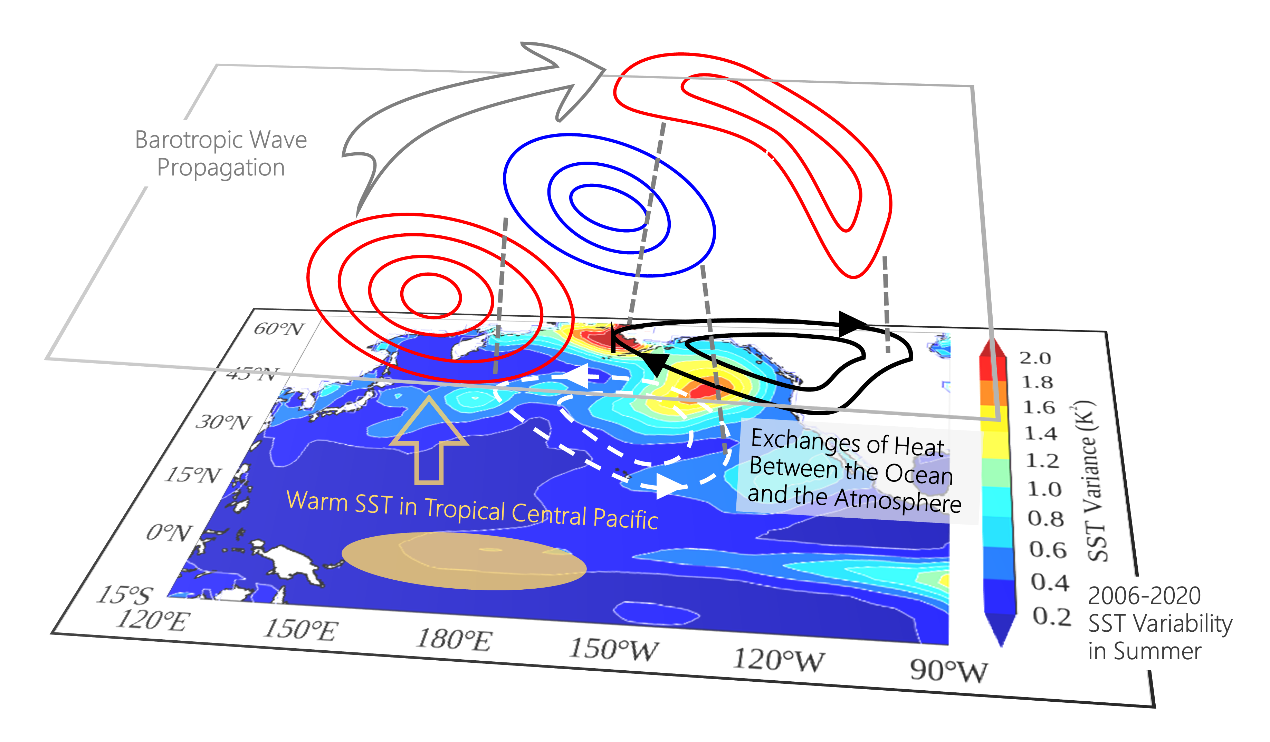


FIGURE: Schematic of the tropical central Pacific warm SST influence on the SST variability over the North Pacific. The warm SST of the tropical central Pacific triggers a northward-propagating barotropic wave and induces corresponding circulation changes near the surface of the North Pacific. The changing circulations weaken the prevailing wind in the North Pacific region, resulting in a reduction of heat transport from the ocean to the atmosphere. The cumulative heat in the surface ocean afterwards lead to increased SST in summer that shows a structure resembling the North Pacific marine heatwave.
In the North Pacific, the variations of the sea surface temperature (SST) are closely related to the atmospheric activities. The interactions between the SST and the atmosphere are widely explained by the theoretical mechanisms including the “Wind-Evaporation-SST feedback” and the “Cloud-Radiation-SST feedback.” The former mechanism describes a positive correlation between the prevailing wind and the evaporation process on the ocean surface. An increase in the wind speed is accompanied by a stronger evaporation of the ocean water that leads to an increase of heat transport from the ocean to the atmosphere and a cooling SST. The latter mechanism represents the role of sea surface low-level cloud cover (e.g., stratus cloud) in modulating the solar radiation penetrating to the ocean surface. An increase in solar radiation associated with the decreased low-level cloud will heat the SST.
In the most recent decade (e.g., 2013-2015 winter and 2019 summer), extremely warm SST appeared in the Northeast Pacific region, which are also known as the North Pacific marine heatwaves. The occurrence of the warm SST extremes had influences on local marine ecosystems, the fisheries along the west coast of North America, and climate systems of the surrounding areas. Relevant studies have pointed out the contribution of atmospheric circulations to the formation of North Pacific marine heatwaves. Our recent study also found that the SST variability of the Northeast Pacific also manifests significant changes in summer after 2000, with a spatial pattern that resembles the marine heatwave events. Therefore, studying the causes for the changing SST variability of the summertime North Pacific would have an advantage in understanding the mechanisms behind the marine heatwaves.
In the present study, we used a general circulation model and designed a numerical experiment to investigate the impact of the tropical central Pacific warm SST on the North Pacific SST variability. Our simulation results indicated that the warm SST in the tropical central Pacific can trigger an atmospheric wave in the upper troposphere during spring, which propagates from the tropics to the North Pacific. This atmospheric wave further induces corresponding circulation changes on the sea surface, which weakens the prevailing wind and the associated Wind-Evaporation-SST feedback. The suppressed heat transport from the ocean to the atmosphere afterwards lead to a marine heatwave-like warm SST over the North Pacific in the following summer. Our results also imply a close interaction between climate systems of the tropics and the middle latitudes during the recent two decades.
Key points
More information